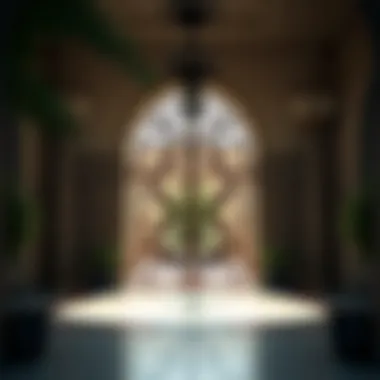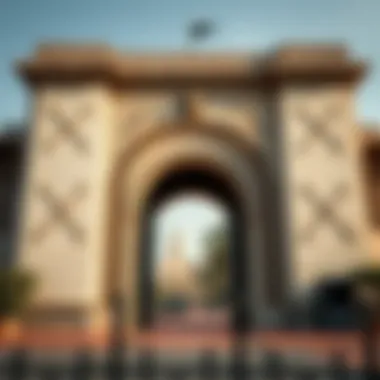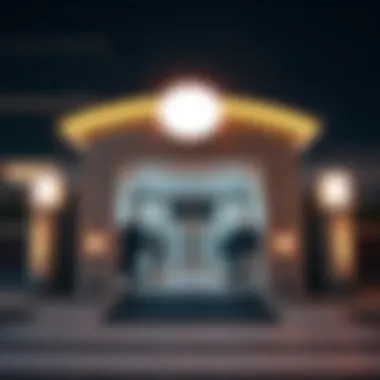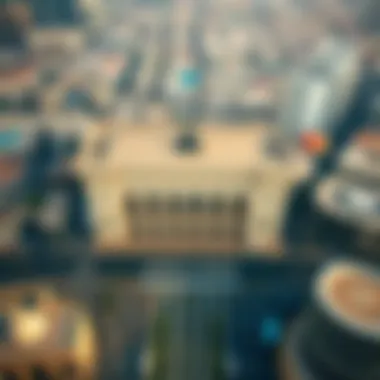Discovering Dubai's Gates: A Cultural and Architectural Journey


Intro
Dubai, a city that boldly juxtaposes opulence with tradition, stands as a testament to architectural splendor. At the heart of this urban marvel are its gates, not merely portals to different neighborhoods, but symbols that embody the rich tapestry of culture, history, and progression. Each gate tells a unique story—of a skyline that rises steadily, of a society evolving amid global influences, and of a real estate landscape that has become a beacon for investors.
Through this exploration, we will dissect the impressive architecture of these gates, their significance in a rapidly modernizing city, and how they weave into the broader narrative of Dubai’s development. This article serves not just to celebrate these structures, but also to inform keen investors, agents, and individuals interested in understanding the depth of Dubai’s urban environment.
The gates are intricately tied to practical aspects of the city—economic and political nuances that shape its very fabric. In the coming sections, we will delve into market insights revealing current real estate trends and factors influencing property prices. Following this, the investment opportunities will spotlight the prime areas for property investment, along with legal considerations for potential foreign investors. Each layer of understanding will equip you to navigate the urban landscape surrounding Dubai's architectural masterpieces.
Prolusion to Dubai's Gates
Dubai's gates are far more than just entry points; they embody the city’s timeless connection between its rich past and future aspirations. As the emirate has blossomed from a small fishing village into a global hub, these architectural symbols have emerged as key storytellers, chronicling Dubai's evolution throughout decades. By unraveling the significance of its gates, this article aims to highlight not only their aesthetic appeal but also their role in shaping societal interactions, boosting economic endeavors, and enhancing urban landscapes.
Focusing on elements like historical context and architectural features provides insights into why these structures are crucial to understanding Dubai's identity. Investors and urban enthusiasts alike will recognize that each gate reflects deeper values of community, tradition, and innovation, further enriching the practical understanding of this vibrant city.
Historical Context
The historical context of Dubai's gates reveals an intricate tapestry woven through time. Early settlements depended heavily on the waterways for trade, leading to the establishment of entryways, often made of coral and stone, that set the tone for security and prosperity. The city's relationship with the sea brought numerous influences from neighboring regions, shaping the architecture and purpose of its gates.
Throughout the 20th century, as oil wealth emerged, the city witnessed rapid urbanization. New gates began to reflect both the historic ties to the past and the aspirations for modernization. This period was marked by an infusion of innovative designs, embodying the spirit of growth and the integration of traditional Arabian architectural styles with contemporary flair. The historical backdrop serves as a reminder of how these gates are not just physical barriers but pivotal landmarks that resonate with the local culture and history.
Architectural Features
The architectural features of Dubai's gates showcase a confluence of artistic expression and functional design. Typically adorned with intricate arabesque motifs and grand arches, these gateways encapsulate the essence of Middle Eastern architecture. The use of materials such as limestone, glass, and steel reflects a harmonious blend of tradition and modern technology.
In many instances, the gates are designed to welcome visitors with open arms, often featuring expansive plazas that invite interaction and engagement. For instance, the ornate decoration seen in the Al Maktoum Gate not only serves an aesthetic purpose but also symbolizes unity and hospitality.
Moreover, sustainable practices are often integrated into the design process, with some gates featuring solar panels or rainwater harvesting systems, embodying Dubai’s commitment to eco-friendly growth.
In summary, the exploration of Dubai's gates provides a rich insight into the city’s narrative, underlining how these structures are much more than mere passageways—they serve as vessels of cultural significance and architectural grandeur.
Cultural Relevance of the Gates
The gates of Dubai serve as more than just architectural structures; they are pivotal symbols that encapsulate the rich cultural tapestry of the city. Each gate tells a story, reflecting the transformation of Dubai from a modest trading port into a global hub. Understanding the cultural relevance of these gates provides insight into their importance in the sociocultural and economic landscape of Dubai. Their designs often integrate elements from traditional Arabic architecture while embracing modernity, thus bridging the past and the present.
Symbolism in Design
Gates in Dubai often carry profound symbolic meanings, deeply rooted in the local heritage and the aspirations of the inhabitants. For instance, the Al Maktoum Gate features intricate patterns inspired by Islamic art, incorporating geometric shapes that narrate a tale of unity and strength. This symbolism resonates with the locals, reflecting their cultural identity and values.
Furthermore, the incorporation of local materials and craftsmanship in these designs emphasizes the connection between the city's heritage and its rapid development. The use of stone, wood, and glass in construction not only adds aesthetic value but also fosters a sense of belonging among the residents. Each gate stands more than just a passageway; it embodies the spirit of Dubai, a city that cherishes its past while robustly pursuing the future.
"Architecture is the frozen music of a culture. The gates of Dubai play their notes, telling stories of tradition, ambition, and artistry."
Cultural Celebrations and Events
Cultural celebrations and events often find their backdrop at these gates, which double as stages for various public festivities. The Dubai Shopping Festival, for instance, utilizes these architectural marvels to showcase local art and crafts, drawing both residents and tourists to experience the vibrancy around them. During such celebrations, the gates become meeting points, facilitating not just commerce but also cultural exchange.
Moreover, public events such as the UAE National Day or Eid festivities turn these gates into platforms for communal gathering and celebration. During these occasions, decorations and light displays transform the gates into stunning spectacles, allowing the community to come together in a shared expression of pride and joy. This role reinforces the gates' importance as cultural landmarks, emphasizing their status as focal points for social interaction and community bonding.
By comprehending the symbolic aspects and the role of cultural events surrounding these gates, one can fully appreciate their significance in Dubai's evolving narrative. Ultimately, they represent a blend of tradition and modernity, serving as reminders of the rich cultural context within which the city operates.
Major Gates in Dubai


The gates of Dubai serve as more than just entrances or exits; they represent significant landmarks that embody the city's rapid growth and evolution. Each gate is a piece of history, a brushstroke within the larger canvas of Dubai's urban landscape. Understanding these gates provides insights not only into the architectural splendor of the city but also into the socio-economic changes that have taken place over the decades.
As the city has burgeoned, its gates have transformed into vital junctions that foster connectivity, support trade, and enhance tourism. They have become symbols of progress, bridging the gap between Dubai's storied past and its dazzling future. This section captures the essence of three major gates, each a unique masterpiece in its own right, serving multiple roles in shaping the city’s character.
The Al Maktoum Gate
The Al Maktoum Gate is not just an architectural marvel; it signifies the entrance to the legacy of the Dubai ruling family. Named after Sheikh Maktoum bin Rashid Al Maktoum, the gate serves as both a tribute to the past and a beacon for future developments.
Visually, its design features traditional Islamic elements that resonate with the historical architecture in Dubai. The intricate patterns and geometry reflect a deep appreciation for cultural heritage while offering functionality in terms of traffic management and urban flow. Beyond aesthetics, this gate facilitates movement into some of Dubai's most vibrant districts, drawing in residents and tourists alike. Its importance as a nexus of connectivity cannot be overstated, as it plays a pivotal role in daily commutes and tourism traffic.
Key Features:
- Cultural Significance: Represents the historical lineage of Dubai's rulers.
- Architectural Style: Incorporates traditional Islamic design elements.
- Practical Implications: Enhances traffic flow and accessibility to significant locales.
The Dubai Creek Gate
The Dubai Creek Gate is where history and modernity intersect. This gate stands at the symbolic heart of the city, acting as a gateway to the historic Dubai Creek area. This creek has been the lifeblood of trade since antiquity, serving as a hub for merchants and fishermen alike.
The structure reflects Dubai’s rapid development while still paying homage to its roots. The incorporation of modern materials and innovative design alongside traditional motifs creates a unique aesthetic that attracts both locals and tourists. The integration of waterfront spaces promotes social interaction, further expanding the role of the Creek Gate as a cherished focal point in the community.
Key Features:
- Historical Relevance: Positioned at the confluence of trade and cultural exchange.
- Design Characteristics: Blends modern and traditional architectural elements.
- Community Engagement: Encourages social activities through vibrant public spaces.
The Burj Al Arab Gate
When one thinks of iconic architecture in Dubai, the Burj Al Arab often comes to mind. Serving as the gateway to this luxurious hotel, the Burj Al Arab Gate is synonymous with extravagance and innovation. Its striking silhouette reflects the aspirations of the Emirate and its commitment to architectural excellence.
Functionally, this gate manages the flow of visitors to one of the most renowned hotels globally while providing secure access for high-profile guests. Its importance goes beyond purely logistic; it represents Dubai’s ambition to position itself as a leader in luxury tourism. The gate seamlessly combines beauty and utility, ensuring that visitors have a memorable experience from the very moment they arrive.
Key Features:
- Architectural Icon: Stands as a symbol of Dubai’s luxury and innovation.
- Visitor Management: Facilitates secure and efficient access for tourists and guests.
- Cultural Impact: Enhances Dubai’s global reputation as a luxury destination.
Understanding the significance of each gate reveals a tapestry of functionality, design, and cultural heritage. By exploring the Al Maktoum, Dubai Creek, and Burj Al Arab gates, one gains insights into the foundational pillars that support the urban landscape of Dubai.
Gates and Urban Development
The relationship between the gates of Dubai and urban development is a profound one. These structures do not merely serve as entrance points; they epitomize the city's ambition and growth. As Dubai propels itself into a future defined by innovation and modernity, the gates serve as both landmarks and vital components that influence the broader urban fabric of the city.
Accessibility and Connectivity
Impact on Transportation
The gates significantly enhance transportation in Dubai. They act as pivotal junctions that facilitate movement across the city, linking communities and encouraging the flow of both people and goods. For instance, the Al Maktoum Gate allows for seamless transit between vibrant districts, reducing congestion and transit times. This characteristic makes it a critical element for those investing in urban planning and transport infrastructure.
A unique aspect of this impact is the introduction of integrated transportation systems surrounding the gates. Buses, taxis, and even ride-sharing services converge at these points, creating a hub of accessibility. The advantages of this connectivity are manifold:
- Easier commute for residents
- Boost to local businesses due to increased foot traffic
- Environmental benefits as efficient transit reduces individual vehicle use
Yet, not without its challenges, the infrastructure around these gates must evolve continually to address rising demands as the city grows.
Integration with Public Spaces


Integrating public spaces with the gates of Dubai elevates the urban experience. The gates often lead into well-planned public areas that offer recreational, artistic, and cultural experiences. For example, the Dubai Creek Gate opens up to parks and promenades where families can unwind, making it a magnet for visitors and residents alike.
This integration is a valuable characteristic as it transforms the gates from simple passages into dynamic environments fostering community interactions. Key features include:
- Public art installations that offer cultural narratives
- Green spaces that promote biodiversity
- Event spaces for local festivals and gatherings
However, this integration also comes with considerations such as maintenance and management of these spaces, ensuring they remain accessible, safe, and appealing for all.
Economic Implications
Investment Opportunities
The gates of Dubai present various investment opportunities, particularly for real estate development around these key areas. The influx of residents and tourists generates a steady demand for both commercial and residential spaces. These locations have become highly desirable for real estate investors, due to their strategic positioning and vibrant surrounding environments.
The unique feature of these investments includes mixed-use developments that incorporate housing, retail, and leisure activities. This mix not only provides a lucrative return for investors but also enhances the liveability of urban areas, which is a compelling attraction for potential buyers.
Influence on Local Businesses
Local businesses around the gates thrive thanks to the diverse traffic they encounter daily. Retail shops, cafes, and entertainment venues benefit directly from high visibility and easy access. The characteristic of these gates acting as economic catalysts is evident, supporting local entrepreneurs and fostering a flourishing business environment.
Some key advantages include:
- Increased customer base - The foot traffic translates into higher sales opportunities.
- Networking potentials - Local businesses can collaborate on events, leveraging the gates as platforms for promotions.
- Cultural exchange - International visitors are likely to patronize local businesses, broadening market reach.
The Gates as Tourist Attractions
The significance of Dubai's gates extends well beyond their architectural brilliance and historical roots; they serve as pivotal attractions that draw both locals and visitors alike. These gates not only showcase the grandeur of Dubai’s infrastructure but also embody the city's cultural spirit, offering an immersive experience that enhances tourism. For investors and stakeholders, understanding the implications of these gates in the tourism sector is essential, as they contribute to the overall economic growth and urban identity of Dubai.
Visitor Experience
Guided Tours
Guided tours offer a structured way for visitors to explore the gates, providing insights that enhance their understanding of the structures' backgrounds and significance. These tours typically feature knowledgeable guides who share stories and historical context, allowing tourists to appreciate architectural details that might otherwise be overlooked. One of the standout characteristics of guided tours is the exclusive access they often provide to lesser-known areas or viewpoints, enriching the visitor's experience in a way that a solo visit might not.
However, the downside is that guided tours can sometimes be pricey, and schedules may not align perfectly with travelers' plans, limiting flexibility. Still, many travelers find that the benefits outweigh these potential drawbacks, as having an expert at their side transforms a simple visit into an enlightening journey through time.
Visitor Facilities
The provision of visitor facilities at the gates plays a crucial role in enhancing the overall experience, catering to multiple needs such as information dissemination, rest areas, and engagement activities. Key characteristics of these facilities include multilingual signage, interactive displays, and comfortable seating areas which allow visitors to relax and absorb the surroundings.
These features make the gates not just architectural landmarks but also family-friendly spots where everyone—from curious children to seasoned travelers—can find something of interest. That said, the pressures of maintaining high-quality facilities can be considerable, and if mismanaged, they can lead to diminished visitor satisfaction. In this article, we recognize that while visitor facilities are pivotal for enhancing the tourism experience, their effective management is equally crucial to ensure consistent quality.
Influence on Tourism Trends
The gates of Dubai are more than just entry points; they symbolize a blend of tradition and modernity that attracts a diverse crowd of tourists. The architectural novelty and cultural significance of these structures often lead to unique tourism trends, such as the rise of specialized tours focusing solely on architectural exploration. Furthermore, social media plays an enormous role in shaping these trends, as visually striking images of the gates often go viral, appealing to global travelers looking for their next destination. This influence underscores the importance of considering both aesthetic appeal and cultural resonance when discussing the future of tourism in Dubai, revealing an interconnected landscape where gates stand at the forefront.
Preservation and Maintenance
Preserving the architectural gates of Dubai extends beyond reminiscence; it plays a crucial role in amplifying the city’s cultural landscape. These gates stand not merely as stone or steel structures but as vital symbols encapsulating the spirit and evolution of Dubai. Focusing on their preservation is important for a variety of reasons, encompassing historical significance, tourist appeal, and the economic benefits tied to these iconic structures.
The first order of business in discussing preservation is recognizing that each gate is a product of its time, reflecting not only the architectural trends but also the societal values of the era when it was constructed. Maintaining them ensures that future generations can appreciate their historical context. For investors looking at real estate or tourism opportunities, preserved structures often indicate a region's stability and dedication to heritage. This can drive both foot traffic and interest in surrounding properties.


Conservation Efforts
A multitude of conservation efforts have been crafted to safeguard these gates from the relentless march of time and urban sprawl. These efforts aim to curb degradation while respecting the original designs and materials used. In Dubai, the Dubai Culture and Arts Authority plays a pivotal role in creating guidelines for the upkeep of historical sites.
- Documentation: Regular surveys and assessments help in tracking the conditions of each gate. Detailed records of their architectural details ensure that any restoration work adheres to their original authenticity.
- Local Craftsmen: Involving skilled artisans familiar with traditional techniques not only elevates the craftsmanship involved in restorations but also instills community pride and keeps old trades alive.
- Community Engagement: Educational programs are vital in engaging the public. When locals understand the importance of these structures, they’re more likely to support preservation initiatives. This results in a community rallying around their cultural assets, which can lead to enhanced protection efforts.
Sustainability Initiatives
As Dubai marches towards a greener future, incorporating sustainability into the preservation of its gates becomes essential. Adopting eco-friendly solutions ensures that these structures remain functional without compromising their integrity or the environment.
- Renewable Energy Sources: Integrating solar panels into older buildings without detracting from their aesthetic allows for self-sufficiency while modernizing the infrastructure.
- Water Conservation: Implementing water-efficient landscaping around these gates not only beautifies the surroundings but also aligns with Dubai’s broader goals regarding resource management.
- Adaptive Reuse: Some gates are being transformed into multifunctional spaces. Instead of just serving as monuments, they can host community events and activities, making them relevant in a modern context. This approach not only preserves the physical structure but also revitalizes the cultural significance attached to it.
"Preservation is not about the past; it shapes the future, ensuring that the roots of culture remain strong as we grow."
Future Development of Gates
As Dubai continues to forge ahead, the future development of its gates stands as a pivotal element in its urban planning narrative. The city, known for its ambitious projects, recognizes that these architecturally significant structures play a crucial role in shaping the city's identity. Key benefits to consider when contemplating future developments include the enhancement of local tourism, improvement in transportation efficiency, and the promotion of sustainable practices that align with the vision of a modern metropolis.
Innovative Designs
Smart Infrastructure
In the realm of smart infrastructure, the next wave of gate development emphasizes technology integration. This includes automated entry systems, real-time monitoring of foot traffic, and intelligent lighting that responds to the environment. Such characteristics enhance safety and improve visitor experience. A standout feature here is the use of data analytics to optimize the flow of people, ensuring that peak times are managed smoothly.
This technology not only improves efficiency but also serves the economic goals of Dubai by attracting more visitors. However, the reliance on technology does come with some disadvantages, like increased costs and the need for ongoing maintenance and updates to ensure its effectiveness. Investors should weigh the initial outlay against the long-term benefits of having a tech-driven approach in their development strategies.
Eco-Friendly Solutions
On the other hand, eco-friendly solutions are becoming vital in the development of new gates. The use of renewable materials and energy-efficient designs reflects a growing commitment to sustainable urban living. Key characteristics include solar panels integrated into the structures, along with rainwater harvesting systems that help reduce environmental impact.
These solutions not only save costs in the long run but also increase the attractiveness of the gates to environmentally conscious tourists and residents alike. The downside, though, can be the initial investment required for these systems. Nevertheless, as consumer preference shifts towards sustainability, these eco-friendly initiatives may prove indispensable for future developments.
Expansion Projects
As Dubai gears up for future expansion, numerous projects are on the horizon, aimed at enhancing the functionality and appeal of its gates. With plans to increase the number of access points throughout the city, these expansions are not merely about aesthetics but rather about reinforcing the infrastructure needed to support a growing population. Each expansion project brings with it the necessity for careful planning to integrate seamlessly into the existing frameworks while providing easy access for both residents and tourists.
Investors should keep a keen eye on these developments, as they are ripe for opportunities. Such projects not only enhance the gates' role within the urban landscape but also underline Dubai's relentless spirit of progress.
End
The exploration of Dubai's gates unfolds a narrative that intertwines history, culture, and modern development. These structures serve not merely as entry points to the city but as symbols of its evolution and aspirations. The architectural beauty of the gates captures the essence of both tradition and innovation, making them essential landmarks that reflect the unique identity of Dubai. Understanding their significance enriches the narrative of a city that constantly reinvents itself while honoring its roots.
In summary, the gates represent much more than concrete and steel. They embody the stories of a city that has grown from a small trading port to a global hub. Their design often resonates with local artistry and heritage, telling tales of the past while paving the way for future possibilities.
Summary of Insights
The insights gleaned from this detailed examination of Dubai’s gates shed light on several crucial aspects. Here’s a recap of the key observations:
- Architectural Significance: Each gate showcases unique architectural features that blend traditional motifs with modern aesthetics.
- Cultural Importance: The gates serve as venues for cultural events and symbolize the community’s heritage and pride.
- Economic Impact: As tourist attractions and focal points in urban planning, the gates contribute to local economies through tourism and commerce.
- Future Potential: Ongoing development projects suggest that these gates will continue to play vital roles in shaping the city’s landscape and connectivity.
Importantly, investors must recognize that these architectural wonders hold not only aesthetic value but also strategic advantages in real estate planning and investment growth.
Implications for Investors
For investors, the gates of Dubai offer a wealth of opportunities. Here are several considerations for those looking to enter this dynamic market:
- Location Advantage: Proximity to prominent gates often boosts property values, making such locations prime for investment.
- Cultural Marketability: Properties adjacent to famous gates may attract tourists and locals alike, enhancing rental potential and long-term value.
- Urban Growth Patterns: Observing how urban development aligns with the gate locations can provide predictive insights into future growth areas.
- Sustainability Trends: Engaging with initiatives that promote eco-friendly infrastructure will likely resonate well with socially conscious investors.
Understanding the significance of these gates equips investors with a nuanced perspective on Dubai’s ever-evolving landscape. By recognizing their cultural, historical, and economic importance, investors can make informed decisions that harness the potential of Dubai's gates effectively.















